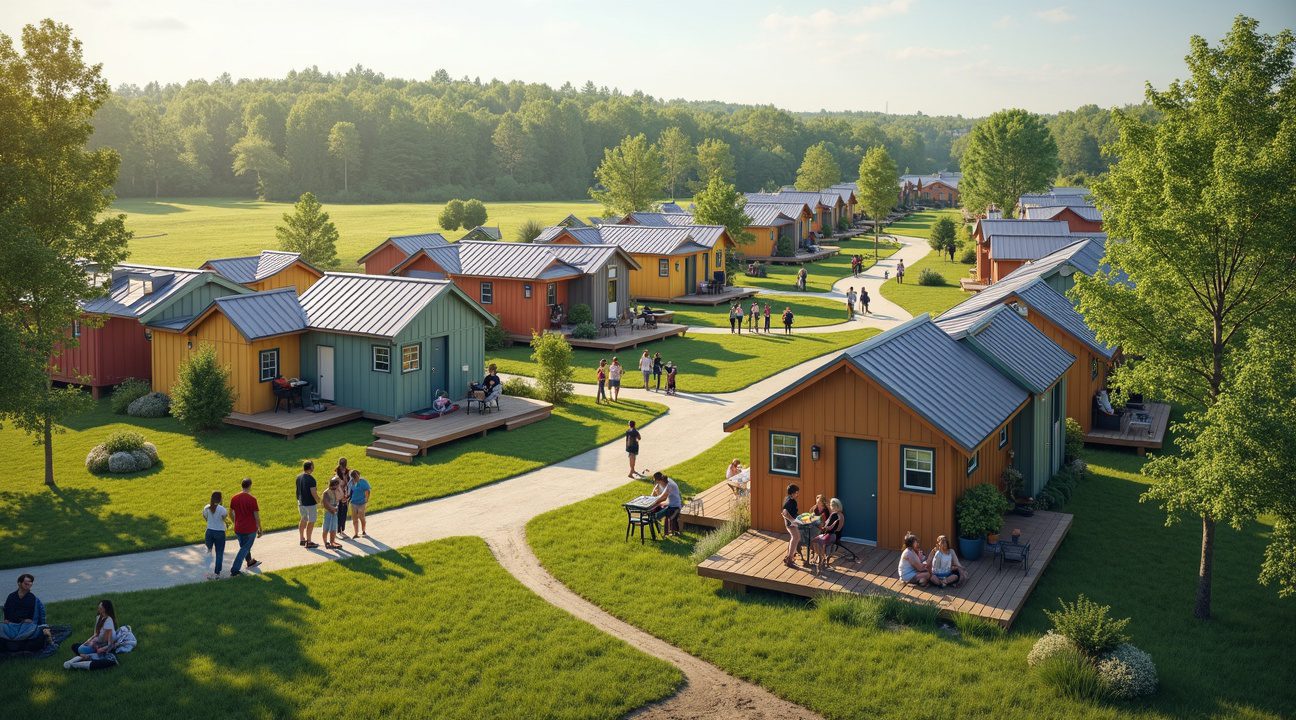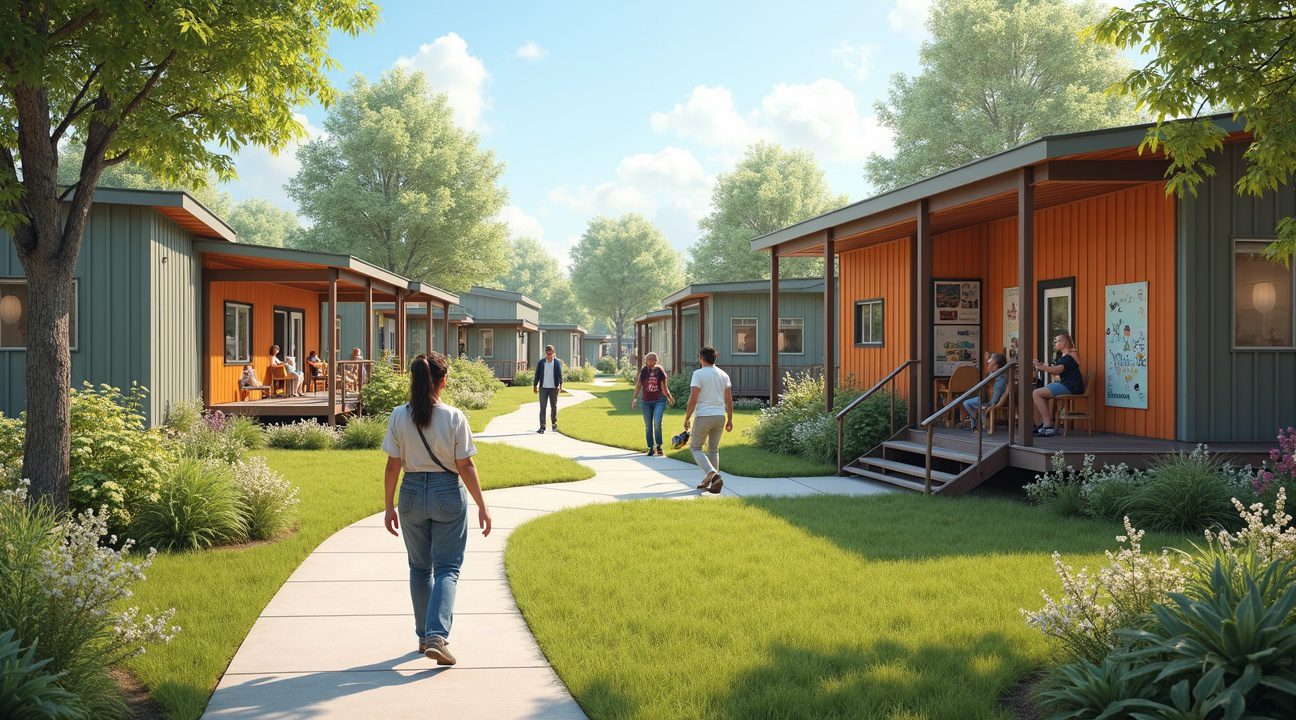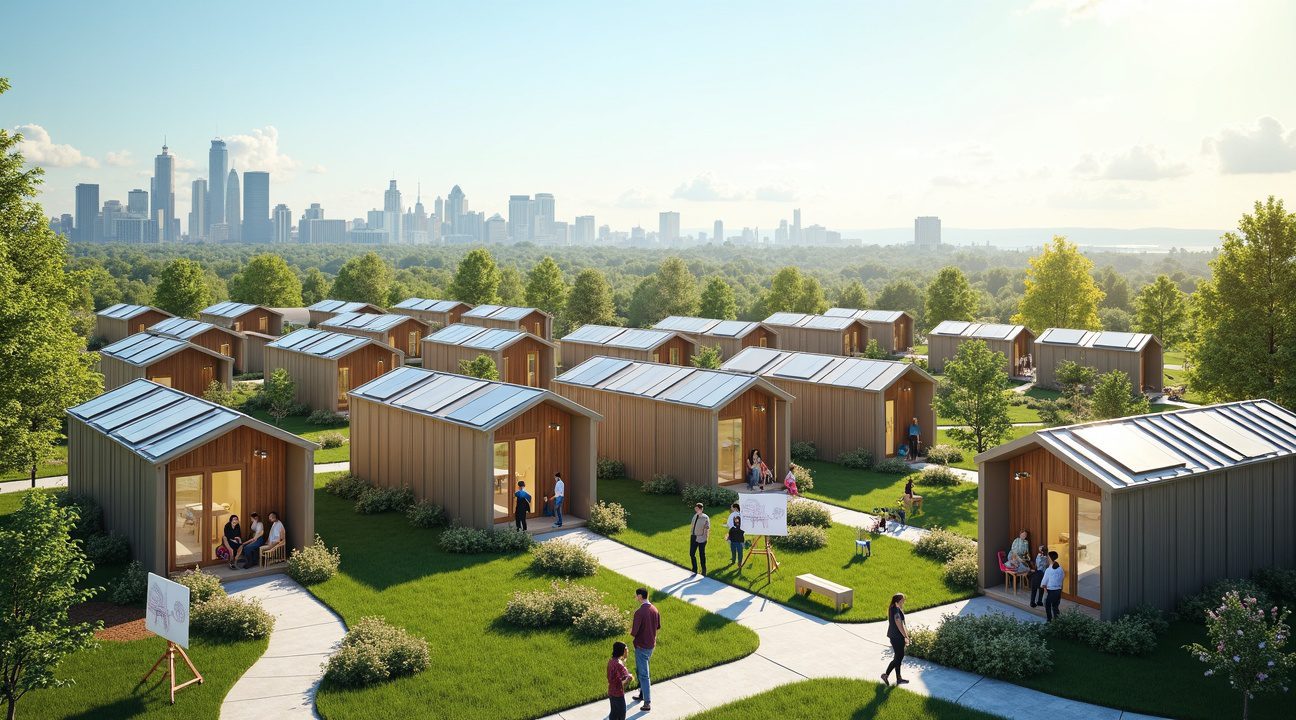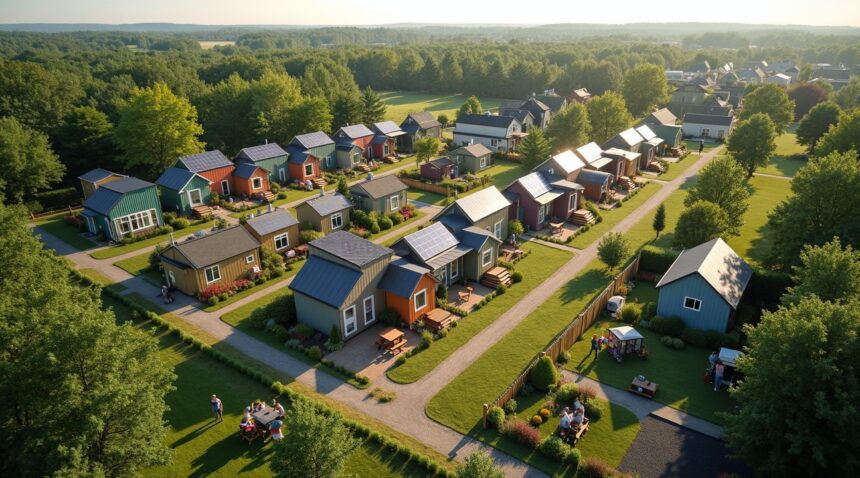Canadian tech entrepreneur Marcel LeBrun turned his $340 million windfall from the sale of Radian6 into Salesforce into a groundbreaking initiative to combat homelessness by creating the 12 Neighbours tiny home village in Fredericton, New Brunswick.
Key Takeaways
- LeBrun invested over $4 million to develop 12 Neighbours, a groundbreaking 99-home tiny house village offering subsidized rent for as little as $200 per month.
- Each solar-powered home ranges from 240 to 294 square feet in size, costs approximately $50,000 to build, and comes fully furnished with crucial amenities. These homes collectively generate up to 300 kilowatts of clean solar energy.
- The village offers holistic support services including on-site healthcare, mental health counseling, and job training programs through in-house carpentry and print shops. Residents also earn above minimum wage.
- Demand for housing in New Brunswick is high—over 700 individuals are waiting for accommodation within the village, and more than 8,000 names are on the province’s affordable housing waitlist.
- This initiative serves as a scalable model that other communities can replicate, illustrating the powerful impact private investment can have in eradicating homelessness with dignity and autonomy.
Learn More
You can find further information and updates on the 12 Neighbours official website.
From Radian6 Sale to Life-Changing Mission: How a $340 Million Tech Exit Sparked a Housing Revolution
When Marcel LeBrun sold his social media monitoring company Radian6 to Salesforce in 2011, the Canadian entrepreneur walked away with approximately $340 million. Most tech founders might have chosen luxury yachts or exotic investments after such a windfall. LeBrun, however, saw an opportunity to address one of society’s most pressing challenges: homelessness.
The Birth of a Housing Vision
Instead of retirement, LeBrun embarked on extensive research and global travel to study homelessness solutions. His journey took him across different countries where he examined various approaches to housing the unhoused population. The entrepreneur didn’t just observe from a distance — he immersed himself in understanding the core issues that traditional shelters and temporary housing programs often failed to address.
Through his research, LeBrun identified three critical elements missing from most homelessness interventions:
- Dignity
- Autonomy
- Lasting transformation
These insights would become the foundation stones for what would eventually emerge as 12 Neighbours, a revolutionary tiny home community in Fredericton, New Brunswick.
Building More Than Just Homes
LeBrun’s commitment to this mission became tangible when he invested over $4 million of his personal fortune into creating the 12 Neighbours community. This wasn’t simply about providing four walls and a roof — the project represents a complete reimagining of how society can support people experiencing homelessness.
The tiny home community operates on principles that distinguish it from traditional housing assistance programs. Each residence provides residents with their own private space, complete with essential amenities and the security that comes with having a place to call home. The design prioritizes individual dignity while fostering a sense of community among residents.
LeBrun has been vocal about his motivation, publicly stating his drive to create a project that offers genuine benefits to individuals without fostering dependency. This philosophy permeates every aspect of the 12 Neighbours initiative, from the physical design of the homes to the support systems built around them.
The entrepreneur’s approach challenges conventional thinking about homelessness solutions. Rather than viewing unhoused individuals as problems to be managed, LeBrun’s model treats them as people deserving of respect, privacy, and the opportunity to rebuild their lives on their own terms. This shift in perspective has created ripple effects that extend far beyond the boundaries of the Fredericton community.
The success of 12 Neighbours has attracted attention from municipalities, social workers, and policy makers across Canada and beyond. LeBrun’s investment has proven that private sector innovation, when combined with genuine social purpose, can create scalable solutions to complex societal problems.
What makes LeBrun’s story particularly compelling is the deliberate choice he made after achieving massive financial success. While other entrepreneurs use their wealth for various philanthropic endeavors, LeBrun’s hands-on approach to solving homelessness demonstrates how tech industry success can translate into meaningful social impact.
The tiny home community represents more than just innovative housing — it’s a testament to what’s possible when entrepreneurial thinking meets social consciousness. LeBrun’s willingness to invest his own resources, time, and reputation into addressing homelessness has created a model that other communities are beginning to explore and adapt.
His journey from tech entrepreneur to housing advocate illustrates how the skills and mindset that drive business success can be channeled into creating lasting social change. The $4 million investment in 12 Neighbours stands as proof that meaningful philanthropy isn’t just about writing checks — it requires vision, commitment, and the courage to challenge existing systems that aren’t working for the people who need them most.
The 12 Neighbours Village: A 99-Home Community Changing Lives $200 at a Time
Marcel LeBrun’s vision for the 12 Neighbours Village took shape on a carefully chosen 55 to 65-acre plot in Fredericton, New Brunswick’s capital city. The entrepreneur purchased this strategic location for approximately $450,000 to $500,000, selecting land that offers both convenience and tranquility. The site sits near public transit and retail stores, ensuring residents maintain easy access to essential services while backing onto peaceful trails that provide a much-needed escape from urban pressures.
Building Hope One Home at a Time
The planned community will house 99 tiny homes when complete, creating Canada’s most ambitious tiny home village dedicated to addressing homelessness. By late 2023, LeBrun’s team had already completed 78 homes, providing shelter for 77 to 80 residents ranging in age from 18 to 71 years old. This rapid construction pace demonstrates the project’s commitment to urgency, with builders completing a new home every four days to reach their ambitious target.
Construction efficiency doesn’t compromise quality or community planning. Each tiny home provides dignity and privacy while maintaining affordability through innovative design and shared resources. The village layout encourages social interaction while respecting individual space, creating an environment where residents can rebuild their lives with support from neighbors facing similar challenges.
Revolutionary Affordable Rent Model
The village’s rent structure breaks traditional affordable housing barriers by charging residents as little as $200 per month in subsidized rent that covers both housing and utilities. This groundbreaking approach ensures no resident pays more than 30% of their income, making housing accessible even for those earning minimum wage or living on government assistance. The pricing model eliminates common barriers that prevent vulnerable populations from accessing stable housing, such as:
- First and last month’s rent requirements
- Credit checks
- High utility costs
This innovative approach addresses systemic issues that have plagued affordable housing initiatives for decades. Rather than waiting for government solutions, LeBrun’s private investment creates immediate relief for those experiencing housing insecurity. The financial burden of housing typically consumes far more than 30% of low-income earners’ budgets, making the village’s model a game-changer for affordability.
The demand for affordable housing solutions speaks volumes about the crisis facing Canadian communities. Over 700 people currently wait for placement in the 12 Neighbours Village, while more than 8,000 names appear on New Brunswick’s provincial affordable housing waitlist. These numbers reflect a broader homelessness crisis affecting communities across Canada, where traditional housing costs have outpaced income growth for vulnerable populations.
Residents experience stability that extends beyond mere shelter. The village provides a foundation for:
- Employment
- Education
- Personal growth
With affordable rent guaranteed, residents can allocate remaining income toward building savings, pursuing training opportunities, or addressing health needs previously neglected due to housing instability.
The initiative represents more than temporary relief; it offers a pathway to permanent housing stability. Many residents use their time in the village to develop skills, build credit, and accumulate savings needed for independent housing. This transitional aspect multiplies the project’s impact by helping individuals break cycles of housing insecurity that can span years or even decades.
LeBrun’s investment creates ripple effects throughout Fredericton’s community, reducing strain on emergency services, shelters, and social programs while demonstrating that private sector solutions can address public challenges effectively. The transformative impact extends beyond individual residents to benefit the broader community through reduced homelessness and increased economic stability for vulnerable populations.

Solar-Powered Tiny Homes: 294 Square Feet of Dignity and Independence
I’ve witnessed countless housing initiatives, but Marcel LeBrun’s vision creates something truly revolutionary. Each tiny home in the 12 Neighbours village spans between 240 to 294 square feet, proving that size doesn’t determine the quality of life. LeBrun ensures every unit functions as a complete living space, incorporating a kitchen, bathroom, and dining area within this compact footprint.
Complete Living Solutions at $50,000 Per Unit
What sets these homes apart isn’t just their size—it’s the comprehensive approach LeBrun takes. Every fully furnished unit costs approximately $50,000 to build and equip, representing exceptional value in today’s housing market. Residents receive everything they need from day one through a detailed starter kit that includes:
- Bedding
- Kitchenware
- Cleaning supplies
This eliminates the financial burden and stress of furnishing a new home, allowing residents to focus on rebuilding their lives.
The tiny home design maximizes every square inch without sacrificing comfort. Residents enjoy private spaces that respect their dignity while providing all essential amenities. Each unit feels like a genuine home rather than temporary housing, which makes a significant psychological difference for people transitioning from homelessness or housing instability.
Environmental Innovation Through Solar Power
LeBrun integrates cutting-edge solar technology throughout the village, generating up to 300 kilowatts of solar capacity. This eco-friendly approach dramatically reduces utility expenses for residents while promoting environmental sustainability. The solar power system demonstrates how affordable housing can also champion green technology, creating a model other communities can follow.
Beyond individual homes, the 12 Neighbours village incorporates shared amenities that strengthen community bonds. Residents access a centralized laundry room, eliminating another potential expense and creating natural meeting points. The on-site medical clinic provides healthcare access that many residents previously lacked, addressing both immediate needs and long-term wellness.
The community garden serves multiple purposes, offering fresh food options while teaching valuable skills and creating shared activities. Cultural movements like Barbie mania show how communities rally around shared experiences, and LeBrun’s garden creates similar bonding opportunities through productive collaboration.
Picnic spaces and gathering areas encourage interaction between neighbors, fostering the connections that transform a collection of tiny homes into a genuine community. These shared spaces recognize that housing stability requires more than four walls—people need belonging and social support to thrive.
LeBrun’s investment in starter supplies demonstrates his understanding that successful housing transitions require comprehensive support. Rather than expecting residents to gradually accumulate household necessities, every home comes equipped with everything needed for immediate occupancy. This approach removes barriers that often prevent people from successfully maintaining housing.
The solar-powered infrastructure reduces long-term operating costs, making the community financially sustainable. Lower utility bills mean residents can allocate more income toward other necessities, creating a pathway toward greater financial stability. The environmental benefits also align with broader community values, showing how innovative housing can address multiple social challenges simultaneously.
Each home’s design prioritizes functionality without sacrificing privacy or comfort. The inclusion of full bathrooms and kitchens gives residents the independence that larger shelters or transitional facilities often can’t provide. MrBeast’s philanthropy shows how individual generosity can create lasting change, and LeBrun’s tiny home community exemplifies this same principle through architecture that restores dignity.
The 12 Neighbours model proves that addressing homelessness doesn’t require massive government programs or decades of planning. LeBrun’s $4 million investment creates immediate, tangible results that transform lives while establishing a replicable framework other entrepreneurs and communities can adapt. These solar-powered tiny homes represent more than innovative housing—they’re instruments of social change that honor human dignity while promoting environmental responsibility.
https://www.youtube.com/watch?v=Q0ftojK8tYw
Beyond Housing: Employment, Healthcare, and Pathways to Independence
I’ve observed how LeBrun’s 12 Neighbours community transforms lives through comprehensive support services that extend far beyond providing shelter. Residents gain access to on-site mental health and addiction counseling, creating a foundation for healing and personal growth. Medical services ensure health needs are addressed without the barriers that often prevent homeless individuals from receiving proper care.
Employment and Skills Development Opportunities
The village operates its own carpentry and print shops, providing meaningful employment opportunities for residents. Workers earn wages that exceed the local minimum wage of $14.75 per hour, offering financial dignity alongside skill development. These career training programs equip individuals with marketable abilities while contributing to the community’s sustainability.
The 12 Neighbours model emphasizes empowerment through education and practical experience. Residents can pursue GED programs and participate actively in community life, building confidence and social connections. This approach recognizes that sustainable independence requires more than just a roof overhead – it demands comprehensive support for mental health services, addiction recovery, and personal development.
LeBrun’s vision creates pathways to independence by addressing the root causes of homelessness rather than simply managing its symptoms. Employment within the village provides structure, purpose, and income while residents work through personal challenges. The integrated approach ensures that as individuals heal and grow, they develop the skills and confidence necessary for independent living.
The success of this model lies in its recognition that each person’s journey differs:
- Some residents may need intensive addiction recovery support
- Others benefit most from skills training and employment opportunities
By offering multiple support services under one roof, the community can adapt to individual needs while maintaining a stable, nurturing environment for all residents.
This comprehensive approach has drawn attention from other communities seeking solutions to homelessness. The model demonstrates that investment in people, rather than temporary fixes, creates lasting change. Residents don’t just survive – they thrive, developing skills, healing from trauma, and building the foundation for independent futures. The village proves that with proper support systems, individuals experiencing homelessness can reclaim their lives and contribute meaningfully to society.
To see more about the community in action, visit the 12 Neighbours official website or watch their latest initiative:
https://www.youtube.com/watch?v=YQn2zBbN9yY

Scaling Solutions: Why One Village Can’t Solve Canada’s Housing Crisis
Marcel LeBrun encountered substantial regulatory obstacles that highlight the systemic barriers preventing rapid housing solutions across Canada. Municipal authorities initially resisted rezoning requirements for the 12 Neighbours project, while federal funding approval stretched over 17 months – arriving well after construction had already commenced. I observe these delays as emblematic of the bureaucratic friction that slows innovative housing initiatives nationwide.
The entrepreneur’s $4 million investment created homes for 99 residents, yet this represents merely a fraction of New Brunswick’s estimated 1,600 homeless individuals. LeBrun himself acknowledges that his village can’t single-handedly eliminate regional homelessness, despite its transformative impact on participating families. Housing experts consistently emphasize that isolated projects, however successful, remain insufficient against Canada’s mounting housing shortage affecting hundreds of thousands of people.
Building a Blueprint for Replication
Advocates and housing specialists stress that scaling requires systematic replication of the 12 Neighbours model across multiple communities. LeBrun actively promotes expansion, sharing construction methodologies and operational frameworks with other regions facing similar challenges. His approach demonstrates how private investment can accelerate progress when streamlined processes bypass traditional funding bottlenecks.
Provincial governments must address policy barriers that slow project approvals and create unnecessary regulatory friction. Experts recommend standardizing tiny home building codes and establishing fast-track zoning procedures for homeless housing initiatives. Such reforms would enable entrepreneurs and nonprofits to replicate successful models without enduring the 17-month delays that plagued LeBrun’s initial efforts.
The path forward demands both private innovation and public policy reform. I recognize that while individual projects like 12 Neighbours create immediate relief for specific communities, systemic change requires coordinated efforts across multiple jurisdictions. LeBrun’s investment proves that entrepreneurs can drive meaningful progress, yet lasting solutions need government support to remove regulatory obstacles and enable rapid scaling across Canada’s diverse housing markets.
Financial sustainability remains crucial for expansion efforts. LeBrun’s model relies on significant upfront capital, which limits replication to wealthy individuals or organizations with substantial resources. Alternative funding mechanisms, including public-private partnerships and impact investment structures, could democratize access to this housing approach. Community movements advocating for housing reform gain momentum when successful projects demonstrate measurable outcomes.
Construction efficiency improvements could reduce per-unit costs and accelerate deployment timelines. LeBrun’s team refined building processes throughout the project, achieving faster assembly times and lower material costs. These operational lessons translate directly to future developments, creating economies of scale that make replication more financially viable. Smart design choices and standardized components enable rapid construction while maintaining quality standards essential for long-term resident satisfaction.
The entrepreneur emphasizes that his village serves as a proof-of-concept rather than a complete solution. Municipal leaders across New Brunswick express interest in similar developments, yet funding constraints and regulatory uncertainty slow implementation. I see this gap between interest and action as characteristic of Canada’s broader housing crisis, where innovative solutions exist but systemic barriers prevent widespread adoption.
Geographic considerations affect replication strategies differently across Canadian regions. Urban areas face higher land costs and complex zoning restrictions, while rural communities often struggle with infrastructure limitations and service accessibility. LeBrun’s suburban location balanced these factors effectively, suggesting that strategic planning can identify optimal sites for similar projects throughout different community types.
Success metrics from 12 Neighbours provide valuable data for scaling efforts:
- Resident retention rates
- Employment outcomes
- Community integration measurements
These indicators offer evidence-based arguments for policy reform and funding allocation. They also strengthen the case for replication while identifying areas where future projects might improve upon LeBrun’s initial model.

The Ripple Effect: Inspiring a Movement Beyond Fredericton
The 12 Neighbours project has sparked conversations about innovative housing solutions across Canada and beyond. LeBrun’s approach demonstrates how strategic private investment can create lasting social impact without relying solely on government funding or traditional charitable models. His $4 million investment serves as proof that entrepreneurs can leverage their success to address pressing community issues while maintaining financial sustainability.
A Blueprint for Community-Driven Solutions
Unlike conventional homeless shelters or transitional housing, the 12 Neighbours village operates on principles that prioritize resident empowerment and self-determination. Each tiny home provides private space, personal agency, and the foundation for individuals to rebuild their lives on their own terms. This model shifts away from temporary fixes toward long-term transformation, creating an environment where residents can develop skills, pursue employment, and establish meaningful connections with their neighbors.
The project’s emphasis on community integration has attracted attention from social innovators across North America. Cities struggling with homelessness are studying LeBrun’s approach, particularly its focus on treating residents as neighbors rather than clients. This philosophical shift creates dignity-based housing that addresses both immediate shelter needs and underlying social isolation that often perpetuates homelessness.
Scaling Impact Through Entrepreneurial Leadership
LeBrun’s success with 12 Neighbours demonstrates how business leaders can apply entrepreneurial thinking to social problems. The project’s measurable outcomes and resident-focused design provide a replicable framework for other communities facing similar challenges. Key elements that make this model attractive include:
- Private funding that reduces dependence on government resources and bureaucratic delays
- Emphasis on resident autonomy that promotes personal responsibility and growth
- Community integration that builds social capital and reduces stigma
- Sustainable operations that ensure long-term viability without ongoing major investments
- Partnerships with local organizations that expand support services without duplicating efforts
The village’s success has influenced how other entrepreneurs view their role in community development. Rather than simply writing checks to existing organizations, business leaders are exploring direct investment in innovative solutions that leverage their skills and resources more effectively. This trend represents a shift from traditional philanthropy to what many call “social entrepreneurship” – applying business principles to create sustainable social change.
Communities across Canada have begun exploring similar initiatives, with several cities initiating feasibility studies for tiny home villages. The model’s adaptability allows for customization based on local needs, climate considerations, and available resources. LeBrun’s transparent sharing of operational details and lessons learned has accelerated this adoption process, creating a network of advocates for dignity-centered housing solutions.
The project also illustrates how addressing homelessness requires more than just shelter provision. By creating a community environment that fosters personal growth and social connection, 12 Neighbours addresses root causes rather than symptoms. This comprehensive approach has influenced policy discussions about homelessness prevention and intervention strategies, with advocates pointing to the village as evidence that innovative models can achieve better outcomes than traditional approaches.
The ripple effects extend beyond housing policy into broader conversations about wealth responsibility and community engagement. LeBrun’s initiative challenges other successful entrepreneurs to consider how their resources could drive meaningful change in their own communities. The project’s visibility through media coverage, including stories about social movements and community initiatives, has amplified its influence and inspired similar commitments from business leaders who previously hadn’t considered direct social investment.
This grassroots approach to solving complex social problems represents a growing trend where private citizens take initiative rather than waiting for government action. The 12 Neighbours model proves that well-funded, thoughtfully designed interventions can create lasting change while respecting the dignity and agency of those they serve. As housing crises persist across urban and rural communities, LeBrun’s example provides both inspiration and practical guidance for leaders ready to invest in transformative solutions.
Sources:
Business Insider: “Rent Starts at $200 a Month in This Canadian Tiny-Home Village”
Maclean’s: “How One Canadian Tech Millionaire Built a Tiny-Home Community”
The Cool Down: “Wealthy CEO builds village of tiny homes in effort help solve …”
Good Good Good: “Tech millionaire uses fortune to build housing for homeless Canadians”
Rogers TV: “Marcel LeBrun’s Mission to End Homelessness”
12 Neighbours official site


